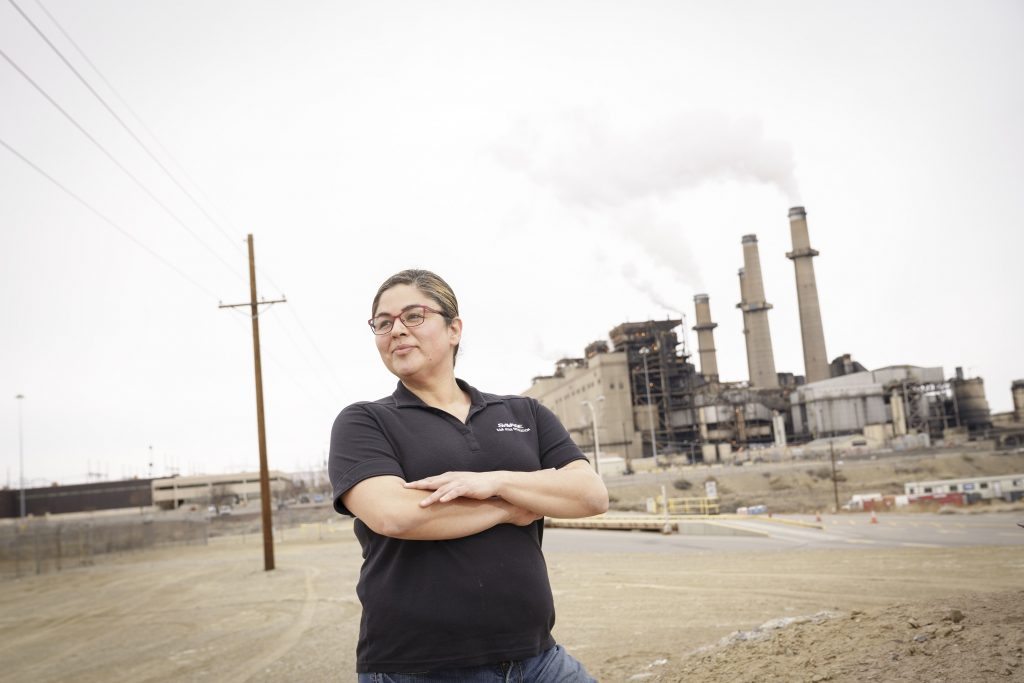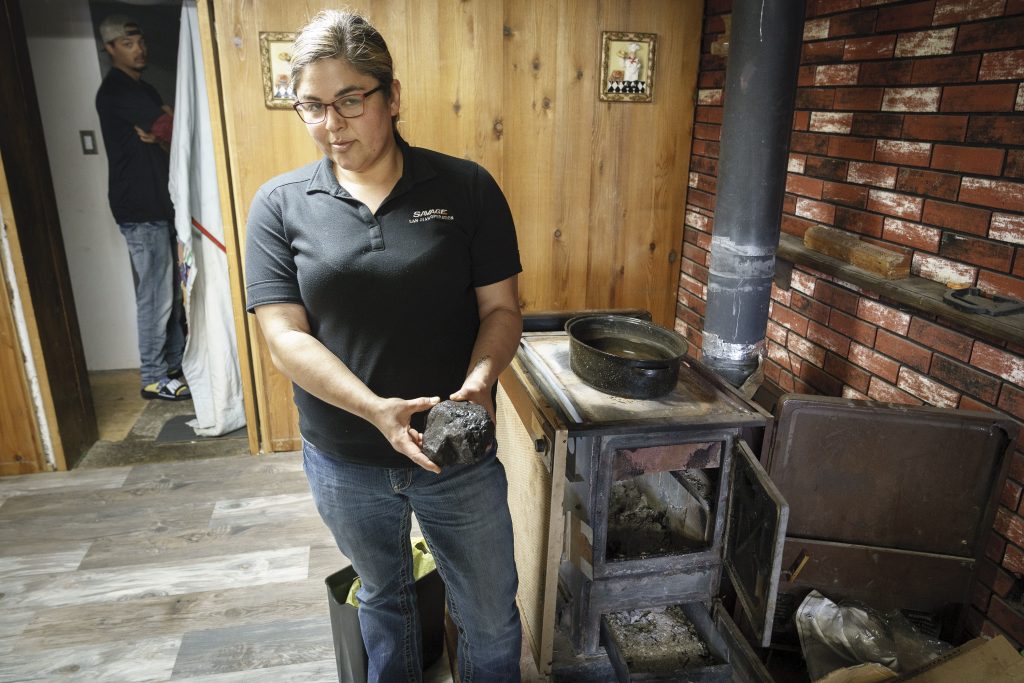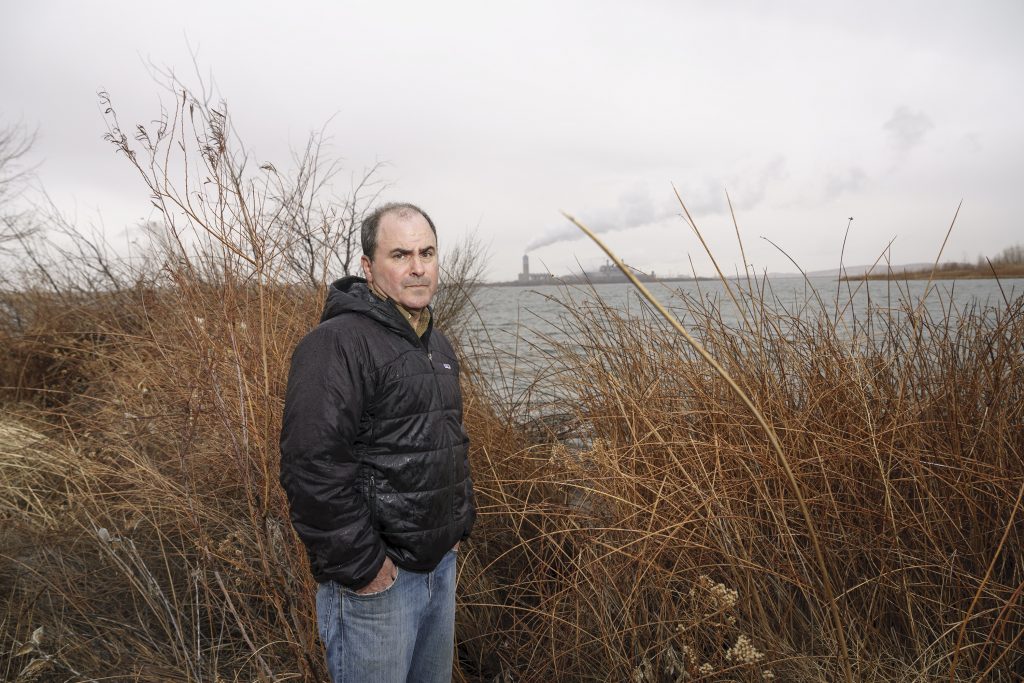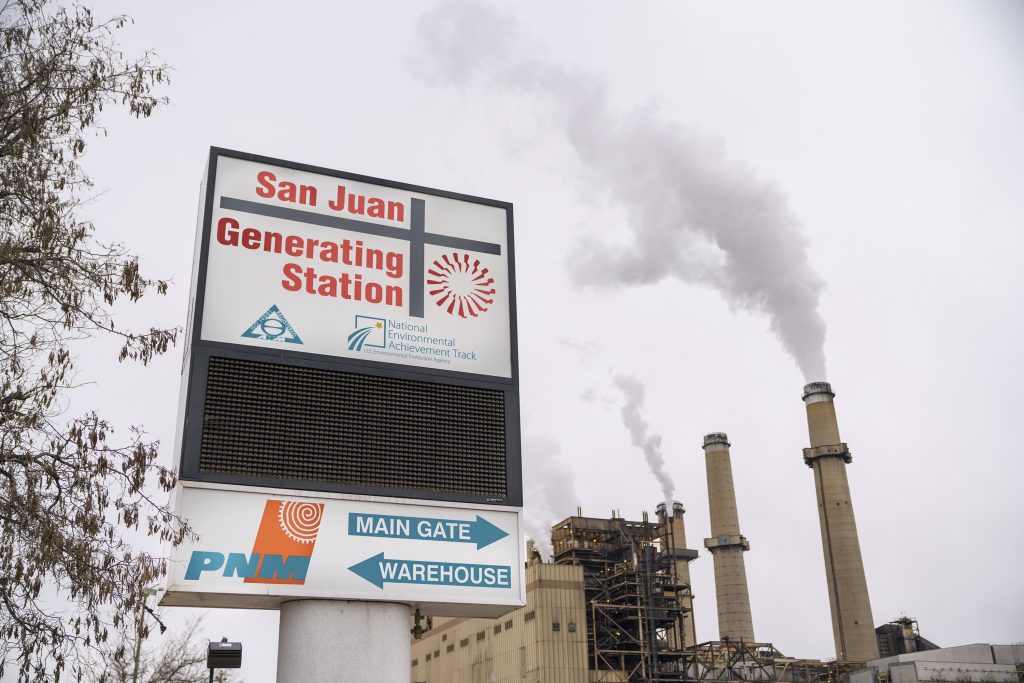By April Reese | Searchlight New Mexico
BLOOMFIELD, NM — Leaning against the wall in a corner of Geneva Griego’s white-paneled living room is a bag of coal. Like many people who live in the Farmington area —part of the coal-rich Four Corners region where New Mexico, Colorado, Arizona and Utah meet — her family relies on a mixture of coal and wood to heat their home. A few feet away, in the kitchen, her 19-year-old daughter Sharon tosses a scoop into the wood stove and closes the small glass door.
For almost 50 years, coal has fueled not only homes in this region but also much of its economy. And the Griego family’s fortunes have been intertwined with coal almost from the beginning. Her mother and father worked at the coal-fired San Juan Generating Station in Waterflow, about 30 miles west of here, in the 1970s and ’80s; today, Geneva and her cousin work there, too. Her job can be stressful: as power production planner, she’s responsible for safely powering down the plant for maintenance. But she likes the challenge, she says, and the pay is good — in the $70,000 to $115,000 range, well above the state’s median household income of $47,169.
But soon, Griego and the community she grew up in will have to learn to live without the plant. Within two years, the San Juan Generating Station and the coal mine that supplies it will close, and Griego, along with 449 other workers, will lose their jobs. A few years ago, Public Service Company of New Mexico (PNM), the plant’s majority owner and the state’s biggest electric utility, announced that the plant — New Mexico’s largest and at one time its most polluting — would be shuttered in 2022, as a consequence of high costs, falling renewables prices and the utility’s new commitment to convert to cleaner energy sources. The mine will close next year.

(Eric Swanson / Searchlight New Mexico)
The closings are part of a larger power switch. Last year, amid a nationwide decline in the coal industry — as solar and wind became cheaper than coal and as public concern about climate change increased — New Mexico lawmakers and Gov. Michelle Lujan Grisham cemented the state’s transition away from coal. A landmark 2019 bill called the Energy Transition Act (ETA) set one of the nation’s most aggressive renewable energy targets: utilities like PNM must switch to 100 percent “zero-carbon” power sources like solar and wind by 2045; rural electric co-ops have until 2050 to de-carbonize. These mandates are the centerpiece of Lujan Grisham’s effort to cut greenhouse gas emissions to 45 percent below 2005 levels by 2030.
To help smooth the economic turbulence from the resulting loss of jobs and tax revenue, the act established a $40 million “just transition” fund, including $20 million for severance pay and worker retraining and $20 million to help Farmington diversify its economy.
Supporters have lauded the plan as a way to cut carbon pollution in the nation’s second-fastest-warming state and capitalize on New Mexico’s abundant solar and wind resources without leaving displaced workers in the lurch.
But for Griego and many others here, the change represents professional and personal upheaval. Workers worry that even with the retraining and severance assistance, they won’t find jobs that pay as well; many positions in the solar industry, for example, pay about half as much. Local officials — already smarting from the decline of the region’s natural gas industry and the recent departure of two major employers, ConocoPhillips and WPX Energy, — fear another wave of population attrition and lost tax revenues as plant and mine workers leave to find work elsewhere.
Some locals have pinned their hopes on a controversial proposal by startup Enchant Energy that would keep the plant open by capturing most of its carbon dioxide before the gas leaves the stacks and selling it to oil and gas companies, which use the CO2 to force more oil out of old wells.
The fracas over the fate of the mine and coal plant is a crucial test of the biggest energy overhaul in New Mexico history — one that will set the course for the state’s economic and environmental future for decades to come.
For Griego, whose family has lived in the Farmington area for seven generations, the closure would take away a job she is proud to have mastered. And it will likely force her to leave her close-knit family and community. She’ll have to look for work out of state, she says, standing in the front yard of her white ranch house on the outskirts of Bloomfield as her 6-year-old son, Damascus, plays with Gabby, the family dog. “I don’t want to give up everything I’ve worked so hard for,” she says.

(Eric Swanson / Searchlight New Mexico)
A community at a crossroads
When the San Juan Generating Station closes, it will become one of hundreds across the country to have flipped the “off” switch for the last time. Coal, once one of the nation’s cheapest and most reliable energy sources, can no longer compete with solar, wind and natural gas, despite attempts by the Trump administration to buoy the industry. From 2010 through the first quarter of 2019, power companies have pulled the plug on more than 546 coal-fired power units nationwide, according to the U.S. Energy Information Administration.
Until PNM shut down two of its four units in 2017, the San Juan plant was one of the country’s biggest polluters. After shuttering the two towers, emissions from the electricity sector fell 26 percent and helped the state achieve a 5 percent drop in greenhouse gas emissions overall. The region’s air quality markedly improved.
Idling the rest of the plant is crucial to the state’s efforts to tamp down emissions, and will further clear the air. The health benefits are substantial. The closing of 334 coal-fired U.S. plants between 2005 and 2016 caused a reduction in air pollution that saved 26,610 lives, according to a recent study by University of California-San Diego researcher Jennifer A. Burney.
And saving lives saves money. Health problems caused by air pollution from the San Juan Generating Station cost the public as much as $240 million over the last five years, according to a 2012 analysis by George D. Thurston, an environmental health professor at New York University who studies the health effects of air pollution. As with all coal-fired plants, air pollution from the San Juan facility is associated with increased hospital admissions, asthma attacks, bronchitis, pneumonia, chronic lung disease, heart attacks, and premature deaths, Thurston concluded. These health problems are costly to treat, cause lost work days and make children miss school.
“We need to move forward with new opportunities that aren’t impacting our health,” says Lawendra Atcitty of Diné CARE, a Navajo environmental group. Atcitty says her son, who has asthma, was symptom-free when they lived in the Pacific Northwest. When they recently moved back to Farmington, she says, the illness returned.

(Eric Swanson / Searchlight New Mexico)
A view of the future
On a windy mesa on the northwest side of Farmington, Mike Eisenfeld of the San Juan Citizens Alliance, a local environmental group, waves a hand at a trio of landmarks in the distance. There’s the San Juan Generating Station on the right and on the left, about a dozen miles away, the Four Corners Power Plant, which PNM will abandon in 2031. Between them, rising from the high desert plain like a jagged crimson sun, is Shiprock pinnacle, the remnant of an old volcano that is sacred to the Navajo people.
Before the closure of the two San Juan units, the haze from the region’s coal-fired power plants was often so dense that the iconic landmark was obscured, Eisenfeld says. Between 2013 and 2018, the San Juan plant exhaled 62 million tons of carbon dioxide, according to federal figures. Now, instead of haze, he sees opportunity in these vast, sun-drenched lands.
“This area out here is perfect for solar,” he says. Northwestern New Mexico is one of the sunniest spots in the Southwest, according to the National Renewable Energy Laboratory’s solar map. The 18,000-acre mine site alone could support more than 2,000 megawatts of solar power, estimates Kelly O’Donnell, a University of New Mexico economist – enough to power about one million homes.
Even with the pain that comes with closing the plant and mine, embracing the transition is Farmington’s best bet, he adds. “Fossil fuels are not coming back.”
The area’s potential for renewables seems unlikely to be fully realized any time soon, however. While the ETA directs that up to 450 megawatts of replacement power be built in San Juan County to offset the lost tax revenues caused by the plant’s closure, it does not explicitly require that all the replacement power come from renewables. Ron Darnell, PNM’s senior vice president for public policy, says using 100 percent renewables is unfeasible because the large-scale battery needed to store renewable power for times of no sun or wind is not yet cost-effective. Instead, PNM’s proposal calls for 350 megawatts of solar, 140 megawatts of wind, and 280 megawatts of natural gas, along with 130 megawatts of battery storage. The proposal is currently being evaluated by the state’s Public Regulation Commission, which will decide whether to approve PNM’s plans.
But the utility underestimates how quickly renewable power storage technologies are advancing, Eisenfeld and others say. Other utilities are already embracing a solar-battery combo, which links solar plants with large-scale storage to keep power flowing 24/7. Xcel Energy, owner of the coal-fired Tolk Generating Station serving New Mexico and Texas, has said a renewables-battery combo could be cost-effective by the time the plant closes in 2032.
To renewable energy advocates, coal’s phase-out presents an unprecedented opportunity — if utilities and affected communities embrace it.
“I think New Mexico has huge potential to not only supply its own needs but also to export it around the region,” says Noah Long, the Natural Resource Defense Council’s regional director for climate and clean energy. The shift will boost local economies and reduce pollution region-wide, he says.
For many local officials, the debate isn’t about one type of power over another, it’s about keeping the economy afloat. None of the replacement power projects will generate enough jobs or tax revenues to replace what will be lost, says San Juan County Manager Mike Stark. “The pain that we’ll feel from the loss of jobs is real, and it’s quite great,” he says. This plant and the mine represent 10 percent of our total tax base,” Stark says. The area already lost 10 percent of its tax base in 2019, after the shuttering of another coal-fired power plant in the region, the Navajo Generating Station, he adds.
San Juan County, San Juan Community College and the Central Consolidated School District are expected to lose about $9 million in property tax revenue when the plant and mine close, an analysis by O’Donnell shows.
PNM’s proposed replacement power strategy would provide only about $1.6 million of property tax. The company’s plan calls for two solar plants to be built outside of the county: one in McKinley County and another in Rio Arriba County.
From fossil fuels to recreation
Even before the ETA’s passage, San Juan County officials began to undertake an ambitious economic diversification scheme. A 2017 regional economic assessment noted the decline of the U.S. coal industry and recommended ramping up economic development efforts and quality-of-life improvements to attract new businesses. Farmington began to aggressively market its outdoor recreation opportunities. Today, “Jolt Your Journey” signs around town point the way to biking, hiking, and off-road vehicle sites — in hopes of luring recreation enthusiasts and new outdoor businesses.
Warren Unsicker, Farmington’s economic development director and head of its Outdoor Recreation Industry Initiative, is an evangelist for the area’s outdoor recreation assets.
An avid mountain biker, Unsicker moved to Farmington with his young family three years ago, after orchestrating a revitalization effort in Tulsa, Oklahoma. He is optimistic that his new city can achieve the same kind of transformation. “It’s an exciting time for Farmington. We’re all rowing in the same direction,” he says “I’ve worked in some towns where it’s like the Hatfields and McCoys. It’s not like that here.”
Driving along a dirt road in the Glade Run Recreation Area, a hilly expanse of Bureau of Land Management lands just north of town, he speaks excitedly about the region’s beauty and its hundreds of miles of biking, hiking and off-road vehicle trails.
“As you can see, it’s a really cool landscape,” he says as he drives past striped sandstone cliffs. Up ahead is an archery range and a small campground. “I think there are a couple of spots where you can get up on top and see Shiprock pinnacle from here.”
On the right side of the road, army-green oil and gas wells and storage tanks emerge into view. Some people question whether mountain bikers and hikers will want to play amid these footprints of industry, but Unsicker thinks the concerns are overblown. “You run into one here and there, but it’s not pervasive,” he says as he passes another well.
The city is also hoping to revive its agricultural roots through a “food hub,” set to open in 2020, where area farmers can promote and sell produce to local restaurants, schools, and other entities, he says.

(Eric Swanson / Searchlight New Mexico)
“It won’t be without pain”
Architects of the ETA say this shift away from coal simply has to happen. Carbon pollution makes up 61 percent of the state’s greenhouse gas emissions, according to the New Mexico Climate Strategy, issued in 2019. If emissions continue unabated, average temperatures in New Mexico could rise up to 14 degrees by 2100, according to the National Oceanic and Atmospheric Administration. That means more drought, water scarcity, wildfires and heat stress on plants, wildlife and people.
“You can’t make every individual or business impacted by this whole. There’s no way. There are going to be folks who are displaced,” says O’Donnell. “And it’s incumbent on the state and the community to help people retrain to other fields.”
Many workers doubt that the retraining and transition funding will help much. Derek Rawson, an engineer at the mine who has lived in Farmington for 24 years, says he and his wife and four kids will likely look for opportunities elsewhere when the mine closes next year. Given that getting a technical degree costs about $24,000, the $8,000 in retraining funding per mine employee “isn’t going to go very far,” he says.
“It’s not going to be enough,” agrees Lorenzo Reyes, San Juan College’s Dean of Workforce and Economic Development. Workers won’t survive financially if they don’t have assistance after their unemployment insurance ends; the state will need to provide more help, he says.
The college is offering career counseling and programs to help people change careers quickly, adds San Juan College President Toni Pendergrass. The courses lean toward fossil fuel industry skills, but some of those skills can be applied to renewable energy or manufacturing as well, she says.
Griego, for one, has already gone back to school, taking online courses at a different college. But even as she prepares for a future without the plant, she harbors hope that it will stay open: “I don’t think some people understand what the impact would be, because it doesn’t affect them.”
Searchlight New Mexico is a non-partisan, nonprofit news organization dedicated to investigative reporting and innovative data journalism in New Mexico.